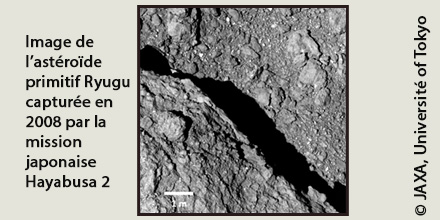
The JAXA Hayabusa2 mission has returned samples from the carbonaceous primitive asteroid Ryugu. IJCLab participated in the analysis of these samples as part of an international group led by Professor Tomoki Nakamura (Univ. Tohoku, Japan). They teach us more about the history of Ryugu.
IJCLab is involved in this study in partnership with several French laboratories: IAS, ICP, ISMO (Univ. Paris-Saclay/CNRS), Synchrotron SOLEIL, IMPMC/MNHN (Sorbonne-University/CNRS), IPAG (Univ. Grenoble-Alpes/ CNRS), IPGP (Univ. Paris Cité/CNRS) and LESIA (Paris-Meudon Observatory/CNRS), with the support of CNES. In particular, the Astrophysics and Cosmochemistry team of the A2C Pole of IJCLab participated in the initial analyzes of these samples, by infrared microscopy at the SOLEIL synchrotron and by IR nanospectroscopy (AFM-IR), in collaboration with ISMO and ICP. The study of these samples, and of a family of micrometeorites resembling Ryugu, is the subject of a thesis in the laboratory (L. Bejach).
Ryugu contains minerals (hydrated silicates, carbonates, magnetite) as well as organic materials and carbonated water. A small proportion of Ryugu's surface minerals formed near the Sun. Ryugu has a composition remarkably similar to the Orgueil meteorite, preserved at the MNHN in Paris since its fall in France in 1864. Orgueil belongs to a rare class used as a reference for the average composition of the solar system. The Ryugu samples offer a unique insight into these primitive materials.The results of Ryugu's analyzes suggest that its parent body formed in regions far from the Sun, which was about 100 km away and formed 2 million years after the formation of the Solar System. Over the next 3 million years, its temperature reached 50°C, leading to aqueous weathering reactions. Subsequently, an impactor (less than 10 km) disintegrated the parent asteroid. Asteroid Ryugu then aggregated from material that was far from the point of impact.





